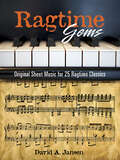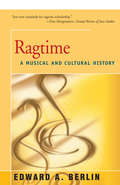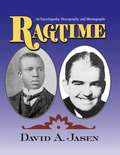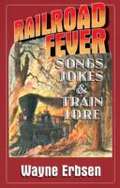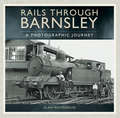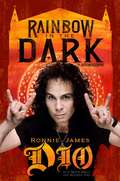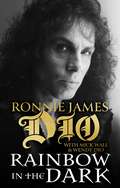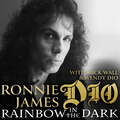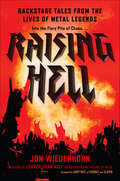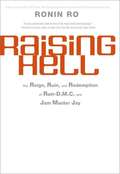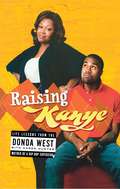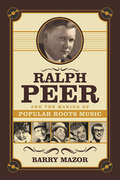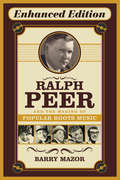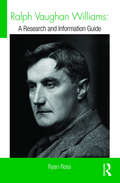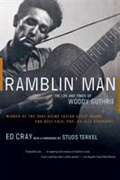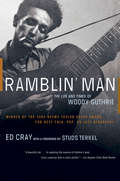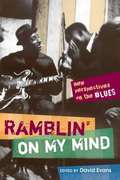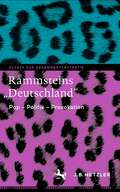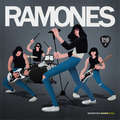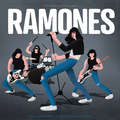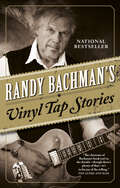- Table View
- List View
Ragtime Gems: Original Sheet Music for 25 Ragtime Classics (Dover Classical Piano Music)
by David JasenHere is a choice selection of 25 of the most famous rags, several of which cannot be found elsewhere. Written during ragtime's golden age from 1904 to 1910, these melodies include three of Scott Joplin's finest works -- Searchlight Rag, Rose Leaf Rag, and Fig Leaf Rag -- plus songs by Tin Pan Alley's hottest composers of the day: George Botsford, Harry Armstrong, and Egbert Van Alstyne.Reprinted from the original editions, the songs in this value-packed volume were selected by David Jasen, a noted ragtime performer as well as a composer and historian of popular music. A splendid array of sheet music accompanies the full musical texts, offering glimpses of popular art from a century ago that range from the serenely beautiful to the eccentric.
Ragtime: A Musical and Cultural History
by Edward BerlinRagtime, the jaunty, toe-tapping music that captivated American society from the 1890s through World War I, forms the roots of America's popular musical expression. But the understanding of ragtime and its era has been clouded by a history of murky impressions, half-truths, and inventive fictions. Ragtime: A Musical and Cultural History cuts through the murkiness. A methodical survey of thousands of rags along with an examination of then-contemporary opinions in magazines and newspapers demonstrate how the music evolved, and how America responded to it.
Ragtime: An Encyclopedia, Discography, and Sheetography
by Dave JasenRagtime: An Encyclopedia, Discography, and Sheetography is the definitive reference work for this important popular form of music that flourished from the 1890s through the 1920s, and was one of the key predecessors of jazz. It collects for the first time entries on all the important composers and performers, and descriptions of their works; a complete listing of all known published ragtime compositions, even those self-published and known only in single copies; and a complete discography from the cylinder era to today. It also represents the culmination of a lifetime’s research for its author, considered to be the foremost scholar of ragtime and early twentiethh-century popular music. Rare photographs accompany most entries, taken from the original sheets, newspapers, and other archival sources.
Rails through Barnsley: A Photographic Journey
by Alan WhitehouseFew people realise it, but Barnsley was once the centre of a railway universe. In Victorian times, dozens of competing companies put forward schemes to build railways across, through and around the town. Between them they constructed what some still regard as the most dense railway network in the country more complicated even than Londons commuter system or even the railway networks of our major cities. The reason almost no one knows about it is because many of the lines built never saw a passenger service. They were built for one reason: coal. A maze of semi-unknown branches served every colliery in the district and the network became so overloaded with coal trains that they even had to build a railway bypass around the town to prevent everything grinding to a standstill!Down the years Barnsleys railway network became something of a backwater, ignored by many enthusiasts and photographers. So the full story of how the railways aided the towns prosperity has rarely been told. This book is an attempt to put that right by giving a relatively short but fact-packed history, looking at each of the railway companies that opened up the town and connecting it with what was going on in the outside world. It includes a collection of high quality images, many of which have not been seen before.As the coal industry rose and fell, so did the railway system which served it, and this book will show exactly how it all happened and why.
Rainbow in the Dark: The Autobiography
by Ronnie James DioThe long-awaited autobiography by one of heavy metal&’s most revered icons, treasured vocalists, and front man for three legendary bands—Rainbow, Black Sabbath, and Dio.Prior to his tragic death in 2010, Ronnie James Dio had been writing his autobiography, looking back on the remarkable life that led him from his hometown in upstate New York to the biggest stages in the world, including the arena that represented the pinnacle of success to him—Madison Square Garden, where this book begins and ends. As Ronnie contemplates the achievement of a dream, he reflects on the key aspects that coalesced into this moment—the close gang of friends that gave him his start in music, playing parties, bars, frats, and clubs; the sudden transition that moved him to the microphone and changed his life forever; the luck that led to the birth of Rainbow and a productive but difficult collaboration with Ritchie Blackmore; the chance meeting that made him the second singer of Black Sabbath, taking them to new levels of success; the surprisingly tender story behind the birth of the Devil Horns, the lasting symbol of heavy metal; his marriage to Wendy, which stabilized his life, and the huge bet they placed together to launch the most successful endeavor of his career…his own band, Dio. Everything is described in great detail and in the frankest terms, from his fallout with Blackmore, to the drugs that derailed the resurrection of Black Sabbath, to the personality clashes that frayed each band. Written with longtime friend of thirty years and esteemed music writer, Mick Wall, who took up the mantle after Ronnie&’s passing, Rainbow in the Dark is a frank, startling, often hilarious, sometimes sad testament to dedication and ambition, filled with moving coming-of-age tales, glorious stories of excess, and candid recollections of what really happened backstage, at the hotel, in the studio, and back home behind closed doors far away from the road. (Black and white photos throughout plus an 8-page 4-color photo insert.)
Rainbow in the Dark: The Autobiography
by Ronnie James DioRonnie James Dio was a heavy metal icon and frontman of three of the best-selling, most influential and famous rock bands in history: Rainbow, Black Sabbath and his own multi-million selling band, Dio. Rainbow in the Dark is a rollercoaster ride through the extraordinary highs and lows of Dio's life, and takes us from his early days as a street gang leader and Doo-wop singer in '60s Vegas through to his breakout success with Rainbow and Black Sabbath in the '70s and the stadiums of US metal in the '80s - ending in Dio's dressing room at Madison Square Garden, in June 1986, at the peak of his worldwide fame with Dio.Tragically Dio passed away from cancer in 2010, but had already begun writing a memoir before his death. Edited by the world-renowned music biographer Mick Wall, with the involvement of Dio's wife of over 35 years and personal manager Wendy Dio, Rainbow in the Dark will honour and feature Dio's never-before-seen original manuscript, while drawing on the extraordinary collection of print and audio interviews with the man himself to produce a vivid, raw and faithful portrait of one of the world's greatest ever rock legends.
Rainbow in the Dark: The Autobiography
by Ronnie James DioRonnie James Dio was a heavy metal icon and frontman of three of the best-selling, most influential and famous rock bands in history: Rainbow, Black Sabbath and his own multi-million selling band, Dio. Rainbow in the Dark is a rollercoaster ride through the extraordinary highs and lows of Dio's life, and takes us from his early days as a street gang leader and Doo-wop singer in '60s Vegas through to his breakout success with Rainbow and Black Sabbath in the '70s and the stadiums of US metal in the '80s - ending in Dio's dressing room at Madison Square Garden, in June 1986, at the peak of his worldwide fame with Dio.Tragically Dio passed away from cancer in 2010, but had already begun writing a memoir before his death. Edited by the world-renowned music biographer Mick Wall, with the involvement of Dio's wife of over 35 years and personal manager Wendy Dio, Rainbow in the Dark will honour and feature Dio's never-before-seen original manuscript, while drawing on the extraordinary collection of print and audio interviews with the man himself to produce a vivid, raw and faithful portrait of one of the world's greatest ever rock legends.
Rainbow in the Dark: The Autobiography
by Ronnie James DioRonnie James Dio was a heavy metal icon and frontman of three of the best-selling, most influential and famous rock bands in history: Rainbow, Black Sabbath and his own multi-million selling band, Dio. Rainbow in the Dark is a rollercoaster ride through the extraordinary highs and lows of Dio's life, and takes us from his early days as a street gang leader and Doo-wop singer in '60s Vegas through to his breakout success with Rainbow and Black Sabbath in the '70s and the stadiums of US metal in the '80s - ending in Dio's dressing room at Madison Square Garden, in June 1986, at the peak of his worldwide fame with Dio.Tragically Dio passed away from cancer in 2010, but had already begun writing a memoir before his death. Edited by the world-renowned music biographer Mick Wall, with the involvement of Dio's wife of over 35 years and personal manager Wendy Dio, Rainbow in the Dark will honour and feature Dio's never-before-seen original manuscript, while drawing on the extraordinary collection of print and audio interviews with the man himself to produce a vivid, raw and faithful portrait of one of the world's greatest ever rock legends.
Raise Your Voice
by Robin WassermanTerri Fletcher longs to be a singer, and signs up for a summer music camp to which her father objects completely. When Terri's brother dies in a car accident, she has to work that much harder, and scheme, to be able to attend.
Raising Hell: Backstage Tales from the Lives of Metal Legends
by Jon WiederhornFrom the author of the celebrated classic Louder Than Hell comes an oral history of the badass Heavy Metal lifestyle—the debauchery, demolition, and headbanging dedication—featuring metalhead musicians from Black Sabbath and Judas Priest to Twisted Sister and Quiet Riot to Disturbed, Megadeth, Throwdown and more. In his song “You Can’t Kill Rock and Roll” Ozzy Osbourne sings, “Rock and roll is my religion and my law.” This is the mantra of the metal legends who populate Raising Hell—artists from Black Sabbath, Judas Priest, Slipknot, Slayer, and Lamb of God to Twisted Sister, Quiet Riot, Disturbed, Megadeth, and many more! It’s also the guiding principle for underground voices like Misery Index, Gorgoroth, Municipal Waste, and Throwdown. Through the decades, the metal scene has been populated by colorful individuals who have thwarted convention and lived by their own rules. For many, vice has been virtue, and the opportunity to record albums and tour has been an invitation to push boundaries and blow the lid off a Pandora’s box of riotous experiences: thievery, vandalism, hedonism, the occult, stage mishaps, mosh pit atrocities, and general insanity. To the figures in this book, metal is a means of banding together to stick a big middle finger to a society that had already decided they didn’t belong. Whether they were oddballs who didn’t fit in or angry kids from troubled backgrounds, metal gave them a sense of identity. Drawing from 150-plus first-hand interviews with vocalists, guitarists, bassists, keyboardists, and drummers, music journalist Jon Wiederhorn offers this collection of wild shenanigans from metal’s heaviest and most iconic acts—the parties, the tours, the mosh pits, the rage, the joy, the sex, the drugs . . . the heavy metal life! Horns up!
Raising Hell: The Reign, Ruin, and Redemption of Run-D. M. C. and Jam Master Jay
by Ronin RoThe year is 1978. Saturday Night Fever is breaking box office records. All over America kids are racing home to watch Dance Fever, Michael Jackson is poised to become the next major pop star, and in Hollis, Queens, fourteen-year-old Darryl McDaniels--who will one day go by the name D.M.C.--busts his first rhyme: "Apple to the peach, cherry to the plum. Don't stop rocking till you all get some." Darryl's friend Joseph Simmons--now known as Reverend Run--thinks Darryl's rhyme is pretty good, and he becomes inspired. Soon the two join forces with a DJ--Jason "Jam Master Jay" Mizell--and form Run-D.M.C. Managed by Run's brother, Russell Simmons, the trio, donning leather suits, Adidas sneakers, and gold chains, become the defiant creators of the world's most celebrated and enduring hip-hop albums-and in the process, drag rap music from urban streets into the corporate boardroom, profoundly changing everything about popular culture and American race relations. Through candid, original interviews and exclusive details about the group's extraordinary rise to the top--and its mortal end brought on by the tragic murder in 2002 of Jam Master Jay--Raising Hell tells of Run-D.M.C.'s epic story, including the rivalries with jealous peers, their mentoring of such legendary artists as the Beastie Boys and Public Enemy, and the battles with producers, record executives, and one another. Ronin Ro delivers a meticulously researched, compellingly written, affecting behind-the-music tale of family, friendship, betrayal, murder, and the building of the culture and industry known as hip-hop.
Raising Kanye: Life Lessons from the Mother of a Hip-hop Superstar
by Karen Hunter Donda West Kanye WestAs the mother of hip-hop superstar Kanye West, Donda West has watched her son grow from a brilliant baby boy with all the intimations of fame and fortune to one of the hottest rappers on the music scene. And she has every right to be proud: she raised her son with strong moral values, teaching him right from wrong and helping him become the man he is today. In Raising Kanye, Donda not only pays homage to her famous son but reflects on all the things she learned about being his mother along the way. Featuring never-before-seen photos and compelling personal anecdotes, Donda's powerful and inspiring memoir reveals everything from the difficulties she faced as a single mother in the African-American community to her later experiences as Kanye's manager as he rose to superstardom. Speaking frankly about her son's reputation as a "Mama's Boy," and his memorable public outbursts about gay rights and President George W. Bush, Donda supports her son without exception, and here she shares the invaluable wisdom she has taken away from each experience -- passion, tolerance, patience, and above all, always telling the truth. Ultimately, she not only expresses what her famously talented son has meant to her but what he has meant to music and an entire generation.
Ralph Peer and the Making of Popular Roots Music
by Barry MazorThis is the first biography of Ralph Peer, the adventurous--even revolutionary--A&R man and music publisher who changed the breadth and flavor of popular music in the United States and around the world. It is the story of the life and 50-year career of the man who was crucial in discovering star musicians and establishing the genres of blues, jazz, country, gospel, and Latin music. It tracks Peer's role in such groundbreaking episodes as recording the record that sparked the blues craze, the first country recording sessions with Fiddlin' John Carson, his discovery of Jimmie Rodgers and the Carter Family at the famed Bristol Sessions, the popularizing of Latin American music during World War II, and the postwar transformation of music on the airwaves that set the stage for the dominance of R&B, country, and rock music.
Ralph Peer and the Making of Popular Roots Music (Enhanced Edition)
by Barry MazorThis enhanced e-book includes 49 of the greatest songs Ralph Peer was involved with, from groundbreaking numbers that changed the history of recorded music to revelatory obscurities, all linked to the text so that the reader can hear the music while reading about it.This is the first biography of Ralph Peer, the adventurous--even revolutionary--A&R man and music publisher who saw the universal power locked in regional roots music and tapped it, changing the breadth and flavor of popular music around the world. It is the story of the life and fifty-year career, from the age of cylinder recordings to the stereo era, of the man who pioneered the recording, marketing, and publishing of blues, jazz, country, gospel, and Latin music.The book tracks Peer's role in such breakthrough events as the recording of Mamie Smith's "Crazy Blues" (the record that sparked the blues craze), the first country recording sessions with Fiddlin' John Carson, his discovery of Jimmie Rodgers and the Carter Family at the famed Bristol sessions, the popularizing of Latin American music during World War II, and the postwar transformation of music on the airwaves that set the stage for the dominance of R&B, country, and rock 'n' roll.But this is also the story of a man from humble midwestern beginnings who went on to build the world's largest independent music publishing firm, fostering the global reach of music that had previously been specialized, localized, and marginalized. Ralph Peer redefined the ways promising songs and performers were identified, encouraged, and promoted, rethought how far regional music might travel, and changed our very notions of what pop music can be.
Ralph Vaughan Williams: A Research and Information Guide (Routledge Music Bibliographies)
by Ryan RossRalph Vaughan Williams: A Research and Information Guide presents the most extensive annotated bibliography of its subject yet produced. It offers comprehensive coverage of the English composer's prose works and accounts for over 1,000 secondary sources from all critical and scholarly eras. A single-numbering format and substantial indexes facilitate efficient searches of what is the most complete bibliography of Ralph Vaughan Williams since Neil Butterworth's guide to research was published by Garland in 1990.
Ramblin' Man: The Life and Times of Woody Guthrie
by Ed CrayA patriot and a political radical, Guthrie captured the spirit of his times in his enduring songs. From Booklist Although Woody Guthrie has been a favorite topic of children's books in recent years, there has not been a substantive adult biography written about him since Joe Klein's definitive Woody Guthrie (1980). Cray (Chief Justice: A Biography of Earl Warren, 1997) may well supplant Klein, as he was given access to the Woody Guthrie Archives, which contain previously unpublished letters, diaries, and journals. Although his narrative is sometimes too thick with details, Cray eloquently sums up the Okie songwriter's sorrowful life, during which he endured his sister's and daughter's deaths by fire, his mother's committal to an insane asylum, and his own diagnosis and death from Huntington's disease. Cray is especially insightful on Guthrie's politics and his deep empathy for Depression-era migrant workers. A man of contradictions, the songwriter emerges as an intellectual who took pains to hide his intellect and as a crusader for social justice who neglected his own family. His second wife, Marjorie, takes on near-heroic stature as the caregiver who, though they were long divorced, looked after him during the last decade of his debilitating illness. Joanne Wilkinson Copyright © American Library Association.
Ramblin' Man: The Life and Times of Woody Guthrie
by Studs Terkel Ed CrayThe groundbreaking biography, available for the centennial of Woody Guthrie's birth in July 2012. A patriot and a political radical, Woody Guthrie captured the spirit of his times in his enduring songs. Ed Cray, the first biographer to be granted access to the Woody Guthrie Archive, has created a haunting portrait.
Ramblin' on My Mind: New Perspectives on the Blues
by David EvansThis compilation of essays takes the study of the blues to a welcome new level. Distinguished scholars and well-established writers from such diverse backgrounds as musicology, anthropology, musicianship, and folklore join together to examine blues as literature, music, personal expression, and cultural product. Ramblin' on My Mind contains pieces on Ella Fitzgerald, Son House, and Robert Johnson; on the styles of vaudeville, solo guitar, and zydeco; on a comparison of blues and African music; on blues nicknames; and on lyric themes of disillusionment. Contributors are Lynn Abbott, James Bennighof, Katharine Cartwright, Andrew M. Cohen, David Evans, Bob Groom, Elliott Hurwitt, Gerhard Kubik, John Minton, Luigi Monge, and Doug Seroff.
Rammsteins „Deutschland“: Pop – Politik – Provokation (Essays zur Gegenwartsästhetik)
by Thomas Ernst Melanie Schiller Christoph Jürgensen Moritz Baßler Lea Espinoza Garrido Kerstin Wilhelms Immanuel Nover Eva Stubenrauch Anna Seidel Matthias Schaffrick Jan-Peter HerbstRammstein provozieren. In ihren Songs und Musikvideos spielt die Band mit Doppeldeutigkeiten rund um die deutsche Geschichte und testet die Grenzen des Sag- und Singbaren. Besonders deutlich wird das in ihrer Single „Deutschland“, einer (Anti?)Hymne auf die Nation. Im cineastisch-bombastischen Musikvideo präsentieren sich die Bandmitglieder unter anderem als KZ-Insassen und SS-Offiziere. Alles nur Spektakel? Oder doch politisch? Das Verhältnis von Politik und Pop zeigt sich bei Rammstein in seinen verschiedenen Dimensionen.
Ramones (Band Records #1)
by Joe Padilla Soledad RomeroLos Ramones explicados a tus hijos. La increíble historia de cuatro amigos que se convirtieron en leyendas del punk rock. Si hay una historia universal de superación esa es la de los Ramones. Y sirve y gusta a todo el mundo. Cuatro inadaptados de Queens, con serios problemas cognitivos, mentales y sociales, lograron el éxito sin saber apenas tocar un instrumento. ¿Su secreto? El amor por la música y la cultura de serie B. Joey, Johnny, Dee Dee y Tommy Ramone son los nombres artísticos de estos cuatro «hermanos» del barrio de Forest Hills, en Queens, que montaron en 1974 su primera formación sin saber que estaban a la vanguardia musical mundial. Tras dos años de tocar en garitos de mala muerte y medio triunfar en la sala de moda neoyorquina, el CBGB, los fichó la discográfica Sire para grabar su primer álbum, el homónimo Ramones. De ahí al mítico concierto en la sala Roundhouse de Londres enjulio de 1976 mediaron unos pocos meses. Podría decirse que dieron el pistoletazo mundial al punk: recibieron en el backstage a grupos que por entonces empezaban, como los Clash o los Sex Pistols. Los inicios de la banda, hasta su primera consagración, están contados en este álbum al alcance de todos los niños y mayores. Una historia de amistad y superación como nunca la has visto. Y más cool que nunca.
Ramones (Band Records #Volumen)
by Joe Padilla Soledad Romero MariñoLos Ramones explicados a tus hijos. La increíble historia de cuatro amigos que se convirtieron en leyendas del punk rock. Si hay una historia universal de superación esa es la de los Ramones. Y sirve y gusta a todo el mundo. Cuatro chavales de Queens lograron el éxito sin saber apenas tocar un instrumento. ¿Su secreto? El amor por la música y la cultura de serie B. Joey, Johnny, Dee Dee y Tommy Ramone son los nombres artísticos de estos cuatro «hermanos» del barrio de Forest Hills, en Queens, que montaron en 1974 su primera formación sin saber que estaban a la vanguardia musical mundial. Tras dos años de tocar en garitos de mala muerte y medio triunfar en la sala de moda neoyorquina, el CBGB, los fichó la discográfica Sire para grabar su primer álbum, el homónimo Ramones. De ahí al mítico concierto en la sala Roundhouse de Londres en julio de 1976 mediaron unos pocos meses. Podría decirse que dieron el pistoletazo mundial al punk: recibieron en el backstage a grupos que por entonces empezaban, como los Clash o los Sex Pistols. Los inicios de la banda, hasta su primera consagración, están contados en este álbum al alcance de todos los niños y mayores. Una historia de amistad y superación como nunca la has visto. Y más cool que nunca. Reseña:«Abrir el libro Ramones (ilustrado y de pequeño formato) es abrir el baúl de los recuerdos de aquellos chavales que en los 70 llevaban un característico corte de pelo. Flequillo largo que tapaba los ojos. Un peinado que marcó a una tribu: los punk.»Carmen Carbonell, Libertad Digital
Ramones: The Unauthorized Biography (Band Bios)
by Soledad Romero MariñoBehind-the-scenes stories and sophisticated artwork will give lifelong buffs and new fans alike a rare glimpse into the world of one of the most iconic bands ever, the Ramones!The Ramones are punk rock. It started in Queens, New York in the early seventies. Four shy boys who couldn't even play instruments got a couple guitars, found some ripped jeans and black leather jackets, and took over the world of punk.Lifelong rockers and new fans alike will love learning more about Joey, Johnny, Tommy, and Dee Dee and their journey to change the world of punk rock forever. So hurry, hurry, hurry, turn up the volume, and discover why their legendary music will continue to live on for generations to come.
Randy Bachman's Vinyl Tap Stories
by Randy BachmanRandy Bachman has been rolling out chart-topping songs his whole life-"You Ain't Seen Nothing Yet," "These Eyes," "American Woman," "Taking Care of Business"-and, since 2005, treating fans to a lifetime of stories on his hit CBC Radio show Randy's Vinyl Tap. His approach is always fresh-even the most hardcore music fans will be surprised by what they can learn from Randy. Writing music and lyrics, performing live and recording #1 songs, producing new music, organizing reunion tours-Randy has done it all. Music is his life, and his anecdotes put you at the centre of it all. These are his best stories. Even with all his success Randy is "still that kid from Winnipeg," and his enthusiasm for great music is as strong as ever. Hear how after years of dreaming Randy finally got to see his musical heroes, The Shadows, play live, and then got to record a Shadows tribute song with longtime friend Neil Young. Encounters with celebrities and rock legends abound, but it is the music that is the driving force behind his extraordinary career, and what brings us back for more stories from Randy's Vinyl Tap.
Randy Bachman's Vinyl Tap Stories
by Randy BachmanRandy Bachman has been rolling out chart-topping songs his whole life--"You Ain't Seen Nothing Yet," "These Eyes," "American Woman," "Taking Care of Business"--and, since 2005, treating fans to a lifetime of stories on his hit CBC Radio show Randy's Vinyl Tap. His approach is always fresh--even the most hardcore music fans will be surprised by what they can learn from Randy. Writing music and lyrics, performing live and recording #1 songs, producing new music, organizing reunion tours--Randy has done it all. Music is his life, and his anecdotes put you at the centre of it all. These are his best stories. Even with all his success Randy is "still that kid from Winnipeg," and his enthusiasm for great music is as strong as ever. Hear how after years of dreaming Randy finally got to see his musical heroes, The Shadows, play live, and then got to record a Shadows tribute song with longtime friend Neil Young. Encounters with celebrities and rock legends abound, but it is the music that is the driving force behind his extraordinary career, and what brings us back for more stories from Randy's Vinyl Tap.
